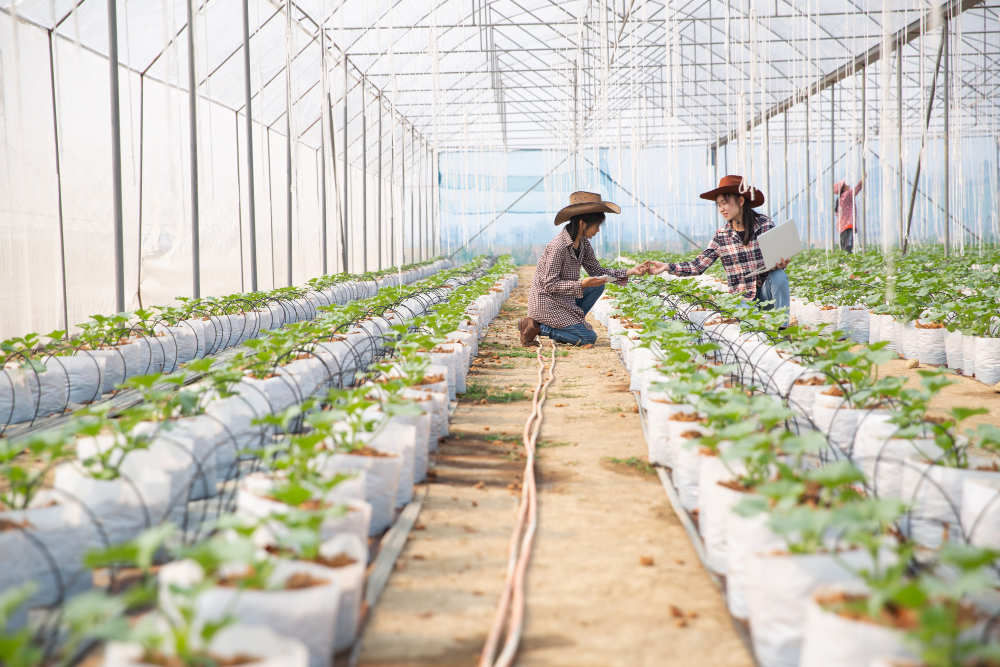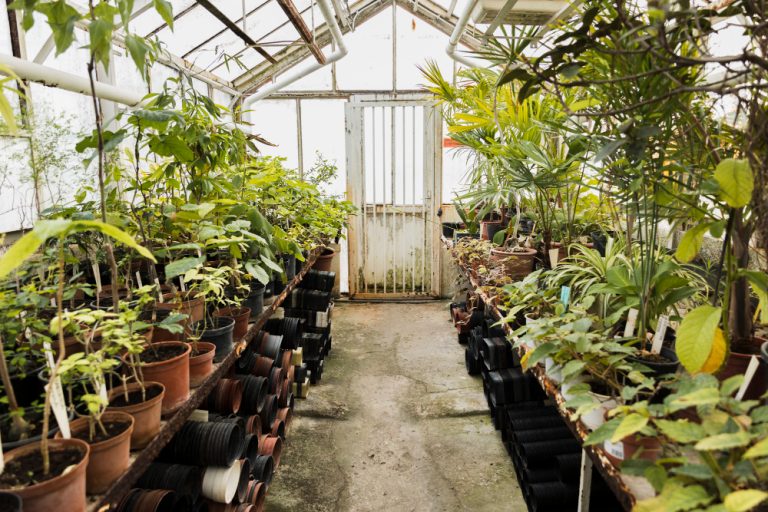
Reasons to Build a Conservatory or Greenhouse
Conservatories and greenhouses offer practical and aesthetic benefits for your property. They extend the growing season by providing a controlled environment, allowing you to grow plants year-round, even in winter. These structures are ideal for cultivating tropical and exotic plants that can’t survive outdoors in colder climates, and they protect plants from harsh weather and pests. You can enjoy fresh, homegrown fruits, vegetables, and herbs, promoting self-reliance and healthier eating.
Conservatories, in particular, serve as beautiful, light-filled living spaces, perfect for relaxation or dining, and can increase your property’s value. Greenhouses also offer entrepreneurial opportunities, such as selling produce at local farmers’ markets, potentially turning your hobby into a small business.
Best Plants for These Structures
The types of plants that thrive depend on whether you have a conservatory or greenhouse:
- Conservatories are best for ornamental plants like palms and ferns, tropical species, cacti, succulents, and potted trees. Small vegetables like patio tomatoes and lettuce can also work if the space is used for living.
- Greenhouses are ideal for a wider range, including vegetables (e.g., tomatoes, peppers, lettuce), herbs (e.g., basil, mint), flowers, and exotic plants like orchids and citrus fruits.
- Some plants, like tropical species and small vegetables, can thrive in both, depending on the setup.
The specific plants that grow best will depend on your local climate, the structure’s insulation, and how you control temperature and humidity.
Survey Note: Detailed Analysis of Conservatories and Greenhouses
This section provides a comprehensive exploration of the reasons to build a conservatory or greenhouse on your property, as well as the types of plants best suited for these structures. The analysis is based on extensive research from various sources, ensuring a thorough understanding for homeowners considering such additions.
Understanding Conservatories and Greenhouses
Before delving into the reasons and plant types, it’s important to clarify the distinction between the two. A conservatory is primarily designed as a living space, often with large glass walls and roofs, serving as an extension of the home for relaxation, dining, or enjoying nature. It typically includes furniture, rugs, and decorative elements, making it aesthetically pleasing and comfortable for human use. In contrast, a greenhouse is a functional structure focused on plant cultivation, with features like adjustable ventilation, temperature control, and shading systems to optimize plant growth. Both can overlap in purpose, but their primary functions differ, as highlighted in sources like Conservatory vs. Greenhouse: What’s the Difference? and Greenhouse or Conservatory: What’s the Difference?.
Reasons to Build a Conservatory or Greenhouse
The decision to build either structure is driven by a range of practical, aesthetic, and economic benefits, as outlined below:
- Extending the Growing Season:
- Both conservatories and greenhouses create a controlled environment that allows plants to grow year-round, extending the growing season into early and late winter months. This is particularly beneficial in regions with short growing seasons, as noted in 10 Reasons to Consider a Conservatory Greenhouse. For example, deep winter greenhouses are ideal for growing out-of-season fruits and vegetables, catering to the increasing demand for local, organic food, as mentioned in Greenhouse or Conservatory: What’s the Difference?.
- Growing Tropical and Exotic Plants:
- These structures provide a warm, humid environment suitable for tropical plants that cannot survive outdoor conditions in colder climates. This is especially appealing for homeowners wanting to cultivate plants like palms, ferns, and orchids, as highlighted in Conservatory Design: Using A Greenhouse As A Room In Your House and Greenhouse vs. Conservatory vs. Solarium.
- Homegrown Food and Self-Reliance:
- Conservatories and greenhouses enable the growth of fresh fruits, vegetables, and herbs, promoting self-reliance and healthier eating. This can lead to cost savings on groceries and aligns with the growing trend of organic, sustainable living, as noted in 10 Reasons to Consider a Conservatory Greenhouse. For instance, you can grow tomatoes, peppers, and lettuce for personal use, enhancing your diet with homegrown produce.
- Aesthetic and Relaxation Space:
- Conservatories, in particular, serve as beautiful, light-filled living spaces that connect the indoors with nature. They are designed for human comfort, often featuring tile floors, fancy light fixtures, and furniture, making them ideal for relaxation, dining, or reading, as described in Conservatory Design: Using A Greenhouse As A Room In Your House. This aesthetic appeal also improves curb appeal and home value, as mentioned in Greenhouse or Conservatory: Which is Better?.
- Increasing Property Value:
- Adding a well-designed conservatory or greenhouse can enhance property value. Conservatories, being more integrated with the home, may add around 5% to property value, while a well-loved garden with a greenhouse is also seen as an asset, as noted in Greenhouse vs conservatory: which one should you choose?. This makes them a worthwhile investment for homeowners.
- Entrepreneurial Opportunities:
- Greenhouses offer the potential for small-scale commercial growing, such as selling fruits, vegetables, and flowers at local farmers’ markets. This can generate additional income while fostering community engagement, as highlighted in 10 Reasons to Consider a Conservatory Greenhouse. For example, you could start a business selling homegrown produce, turning your hobby into a revenue stream.
- Protection from Harsh Weather and Pests:
- Both structures shield plants from extreme weather conditions, such as frost or heavy rain, and protect them from pests and predators. This ensures healthier plant growth and reduces the risk of crop loss, as noted in Greenhouse vs. Conservatory vs. Solarium. This is particularly important for delicate or exotic species that require stable conditions.
Types of Plants That Grow Best in Conservatories and Greenhouses
The types of plants that thrive in these structures depend on their design and purpose. Below is a detailed breakdown, supported by specific examples from the research:
Plants for Conservatories
- Conservatories are primarily living spaces but can support a variety of plants, especially those that don’t require deep soil and thrive in natural light. They are best suited for:
- Ornamental and Tropical Plants: Palms, ferns, and other tropical species that enjoy warm, humid conditions, as mentioned in Conservatory vs. Greenhouse: What’s the Difference? and Can You Use Your Conservatory As A Greenhouse?.
- Potted Plants: Small flowers, large potted trees, and plants that can be managed in containers, as noted in Greenhouse vs. Conservatory vs. Solarium.
- Cacti and Succulents: These are ideal for areas with ample sunlight and minimal watering needs, as highlighted in Conservatory Design: Using A Greenhouse As A Room In Your House, under the “Escape with a good book” idea.
- Specific Examples: Patio tomatoes, dwarf pepper plants, and lettuce can also thrive in conservatories, especially if the space is used for dining or relaxation, as mentioned in the same source under “Outdoor” bug-free dining.
Plants for Greenhouses
- Greenhouses are designed for plant cultivation and offer more flexibility for growing a wider range of plants. They are best suited for:
- Vegetables and Herbs: Tomatoes, peppers, lettuce, and herbs like basil and mint, as noted in Conservatory Design: Using A Greenhouse As A Room In Your House and 10 Reasons to Consider a Conservatory Greenhouse.
- Flowers: A variety of flowers can be grown, especially those requiring controlled temperatures and humidity, as mentioned in Conservatory vs. Greenhouse: What’s the Difference?.
- Exotic and Delicate Species: Plants like orchids and other tropical species that need specific environmental conditions, as highlighted in Greenhouse or Conservatory: Which is Better?.
- Citrus Fruits: Historically, greenhouses have been used to cultivate citrus plants, which require a warm, protected environment, as noted in 10 Reasons to Consider a Conservatory Greenhouse.
Plants Suitable for Both
- Some plants can thrive in both conservatories and greenhouses, depending on the setup:
- Tropical Plants: Palms, ferns, and other humidity-loving species, as mentioned across multiple sources, including Custom Greenhouses and Conservatories: What’s the Difference? and Greenhouse vs. Conservatory vs. Solarium.
- Small Vegetables and Herbs: Lettuce, dwarf peppers, and herbs like basil, as noted in Conservatory Design: Using A Greenhouse As A Room In Your House.
- Flowers: Many flowering plants can adapt to both environments if the lighting and temperature are controlled, as suggested in Greenhouse or Conservatory: Which is Better?.
Comparative Analysis: Conservatory vs. Greenhouse
To help homeowners decide, here’s a table summarizing the key differences and suitability for plants:
| Aspect | Conservatory | Greenhouse |
|---|---|---|
| Primary Purpose | Living space, aesthetic appeal, relaxation | Plant cultivation, functional growing space |
| Best For | Ornamental plants, tropical species, potted trees | Vegetables, herbs, flowers, exotic species |
| Climate Control | Less precise, more integrated with home | Highly controlled, with ventilation and shading |
| Examples of Plants | Palms, ferns, cacti, patio tomatoes, lettuce | Tomatoes, peppers, orchids, citrus, basil, mint |
| Additional Benefits | Increases property value, enhances curb appeal | Entrepreneurial opportunities, year-round crops |
This table, derived from sources like Greenhouse vs conservatory: which one should you choose? and Greenhouse or Conservatory: Which is Better?, helps clarify the choice based on your needs.
Key Considerations for Plant Selection
The specific plants that grow best will depend on several factors:
- Local Climate: The external climate influences the level of insulation and heating required.
- Structure’s Insulation: Well-insulated structures can maintain stable temperatures, crucial for delicate plants.
- Temperature and Humidity Control: Greenhouses often have advanced systems for regulating these, while conservatories may rely on natural light and home heating, as noted in Can You Use Your Conservatory As A Greenhouse?.
- Space and Soil Depth: Conservatories are better for potted plants, while greenhouses can accommodate crops needing deep soil, as mentioned in Greenhouse vs. Conservatory vs. Solarium.
For visual inspiration, you can explore examples like Martha’s Conservatory Greenhouse, which showcases thriving plant collections, though specific plant types are better detailed in the textual sources cited.
Conclusion
Conservatories and greenhouses offer versatile solutions for homeowners looking to enhance their property with plant cultivation and living spaces. Whether you prioritize a relaxing, aesthetic addition (conservatory) or a functional, plant-focused area (greenhouse), both can significantly improve your gardening experience. The choice of plants, ranging from tropical species and vegetables to flowers and herbs, depends on the structure’s design and your specific needs, ensuring a tailored approach to gardening year-round.




